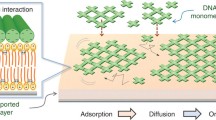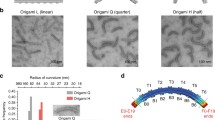Abstract
Molecular self-assembly has attracted much attention as a method to create novel supramolecular architectures. The scaffolded DNA origami method has enabled the construction of almost arbitrarily shaped DNA nanostructures, which can be further used as components of higher-order architectures. Here, we describe a method to construct and visualize two-dimensional (2D) lattices self-assembled from DNA origami tiles on lipid bilayer membranes. The weak adsorption of DNA origami tiles onto the mica-supported lipid bilayer allows their lateral diffusion along the surface, facilitating interactions among the tiles to assemble and form large 2D lattices. Depending on the design (i.e., shape, size, and interactions with each other) of DNA origami tiles, a variety of 2D lattices made of DNA are constructed.
Access this chapter
Tax calculation will be finalised at checkout
Purchases are for personal use only
Similar content being viewed by others
References
Seeman NC (1999) DNA engineering and its application to nanotechnology. Trends Biotechnol 17:437–443
Seeman NC (2003) DNA in a material world. Nature 421:427–431
Rothemund PW (2006) Folding DNA to create nanoscale shapes and patterns. Nature 440:297–302
Douglas SM, Dietz H, Liedl T, Hogberg B, Graf F, Shih WM (2009) Self-assembly of DNA into nanoscale three-dimensional shapes. Nature 459:414–418
Dietz H, Douglas SM, Shih WM (2009) Folding DNA into twisted and curved nanoscale shapes. Science 325:725–730
Liu W, Zhong H, Wang R, Seeman NC (2011) Crystalline two-dimensional DNA-origami arrays. Angew Chem Int Ed Engl 50:264–267
Rajendran A, Endo M, Katsuda Y, Hidaka K, Sugiyama H (2011) Programmed two-dimensional self-assembly of multiple DNA origami jigsaw pieces. ACS Nano 5:665–671
Woo S, Rothemund PW (2011) Programmable molecular recognition based on the geometry of DNA nanostructures. Nat Chem 3:620–627
Zhao Z, Liu Y, Yan H (2011) Organizing DNA origami tiles into larger structures using preformed scaffold frames. Nano Lett 11:2997–3002
Gerling T, Wagenbauer KF, Neuner AM, Dietz H (2015) Dynamic DNA devices and assemblies formed by shape-complementary, non-base pairing 3D components. Science 347:1446–1452
Tikhomirov G, Petersen P, Qian L (2017) Programmable disorder in random DNA tilings. Nat Nanotechnol 12:251–259
Sun X, Hyeon Ko S, Zhang C, Ribbe AE, Mao C (2009) Surface-mediated DNA self-assembly. J Am Chem Soc 131:13248–13249
Aghebat Rafat A, Pirzer T, Scheible MB, Kostina A, Simmel FC (2014) Surface-assisted large-scale ordering of DNA origami tiles. Angew Chem Int Ed Engl 53:7665–7668
Woo S, Rothemund PW (2014) Self-assembly of two-dimensional DNA origami lattices using cation-controlled surface diffusion. Nat Commun 5:4889
Johnson-Buck A, Jiang S, Yan H, Walter NG (2014) DNA-cholesterol barges as programmable membrane-exploring agents. ACS Nano 8:5641–5649
Kocabey S, Kempter S, List J, Xing Y, Bae W, Schiffels D, Shih WM, Simmel FC, Liedl T (2015) Membrane-assisted growth of DNA origami nanostructure arrays. ACS Nano 9:3530–3539
Suzuki Y, Endo M, Sugiyama H (2015) Lipid-bilayer-assisted two-dimensional self-assembly of DNA origami nanostructures. Nat Commun 6:8052
Douglas SM, Marblestone AH, Teerapittayanon S, Vazquez A, Church GM, Shih WM (2009) Rapid prototyping of 3D DNA-origami shapes with caDNAno. Nucleic Acids Res 37:5001–5006
Sato Y, Endo M, Morita M, Takinoue M, Sugiyama H, Murata S, Nomura SM, Suzuki Y (2018) Environment-dependent self-assembly of DNA origami lattices on phase-separated lipid membranes. Adv Mater Interfaces 5:5
Suzuki Y, Sugiyama H, Endo M (2018) Complexing DNA origami frameworks through sequential self-assembly based on directed docking. Angew Chem Int Ed Engl 57:7061–7065
Mingeot-Leclercq MP, Deleu M, Brasseur R, Dufrene YF (2008) Atomic force microscopy of supported lipid bilayers. Nat Protoc 3:1654–1659
Uchihashi T, Kodera N, Ando T (2012) Guide to video recording of structure dynamics and dynamic processes of proteins by high-speed atomic force microscopy. Nat Protoc 7:1193–1206
Mengistu DH, Bohinc K, May S (2009) Binding of DNA to zwitterionic lipid layers mediated by divalent cations. J Phys Chem B 113:12277–12282
Acknowledgments
This work was supported by the Japan Society for the Promotion of Science (JSPS) Grant-in-Aid for Scientific Research (KAKENHI; grant numbers 18 K19831 and 19H04201 to Y.S., 16H06356 to H.S., and 18KK0139 to M.E.). Financial support from the Uehara Memorial Foundation and the Nakatani Foundation to M.E. are also acknowledged.
Author information
Authors and Affiliations
Corresponding author
Editor information
Editors and Affiliations
Rights and permissions
Copyright information
© 2023 Springer Science+Business Media, LLC, part of Springer Nature
About this protocol
Cite this protocol
Suzuki, Y., Sugiyama, H., Endo, M. (2023). Two-Dimensional DNA Origami Lattices Assembled on Lipid Bilayer Membranes. In: Valero, J. (eds) DNA and RNA Origami. Methods in Molecular Biology, vol 2639. Humana, New York, NY. https://doi.org/10.1007/978-1-0716-3028-0_5
Download citation
DOI: https://doi.org/10.1007/978-1-0716-3028-0_5
Published:
Publisher Name: Humana, New York, NY
Print ISBN: 978-1-0716-3027-3
Online ISBN: 978-1-0716-3028-0
eBook Packages: Springer Protocols




